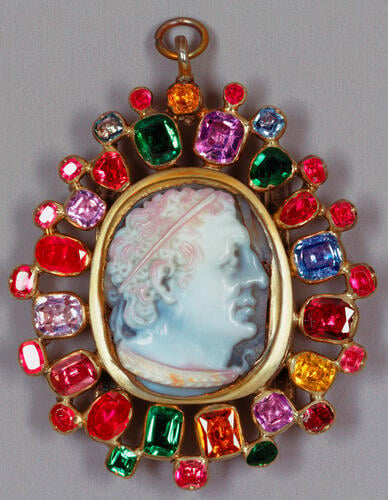-
1 of 253523 objects
Ptolemy I, King of Egypt Cameo late 16th c./early 17th c. Mount early 18th c.
Cowrie shell with slate backing; openwork mount of silver-gilt with inner row of foiled gemstones alternating with smaller outer stones, in closed silver settings (emerald, amethyst, ruby, sapphire, almandine garnet, green paste, hessonite garnet and topaz), suspension loop and ring at top and slides on reverse | 4.4 x 3.5 cm (with fittings) | RCIN 65246
-
Cameo head of Ptolemy I (c.367-282 BC), with a fillet in his hair and in profile to the right. A braided border runs along the neckline. The shell is backed with slate to improve the colour.
The cameo was formerly tentatively identified as Vespasian. The choice of shell for the cameo may indicate a German origin. The early 18th century frame designed to be worn as a slide or pendant may also be German.
Text adapted from Ancient and Modern Gems and Jewels in the Collection of Her Majesty The Queen, London, 2008Provenance
First recorded in the Royal Collection in 1872.
-
Creator(s)
(nationality) -
Medium and techniques
Cowrie shell with slate backing; openwork mount of silver-gilt with inner row of foiled gemstones alternating with smaller outer stones, in closed silver settings (emerald, amethyst, ruby, sapphire, almandine garnet, green paste, hessonite garnet and topaz), suspension loop and ring at top and slides on reverse
Measurements
4.4 x 3.5 cm (with fittings)
2.3 x 2.0 cm (cameo)
Category
Other number(s)
Alternative title(s)
Vespasian (?, previously identified as)
Place of Production
Germany

